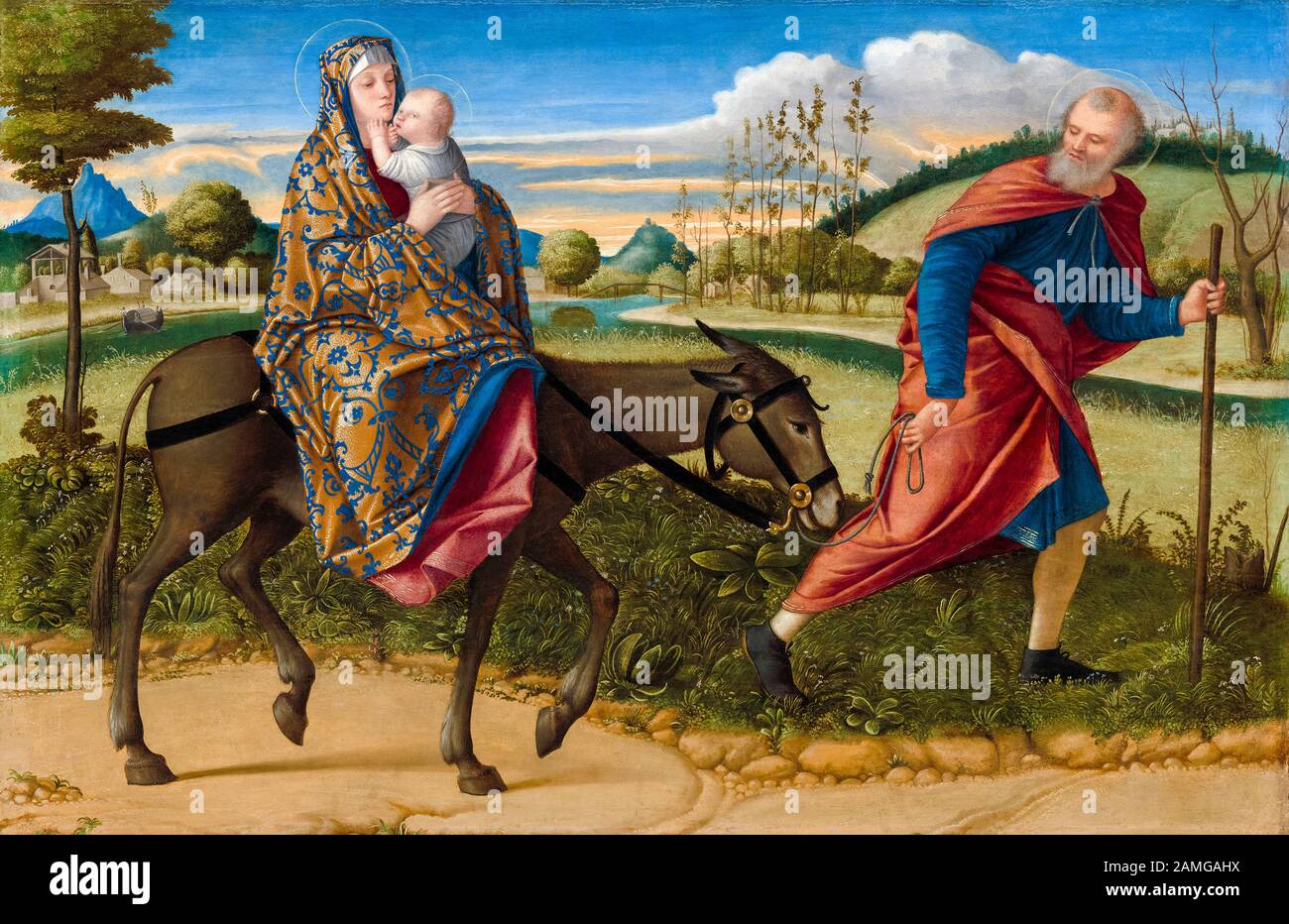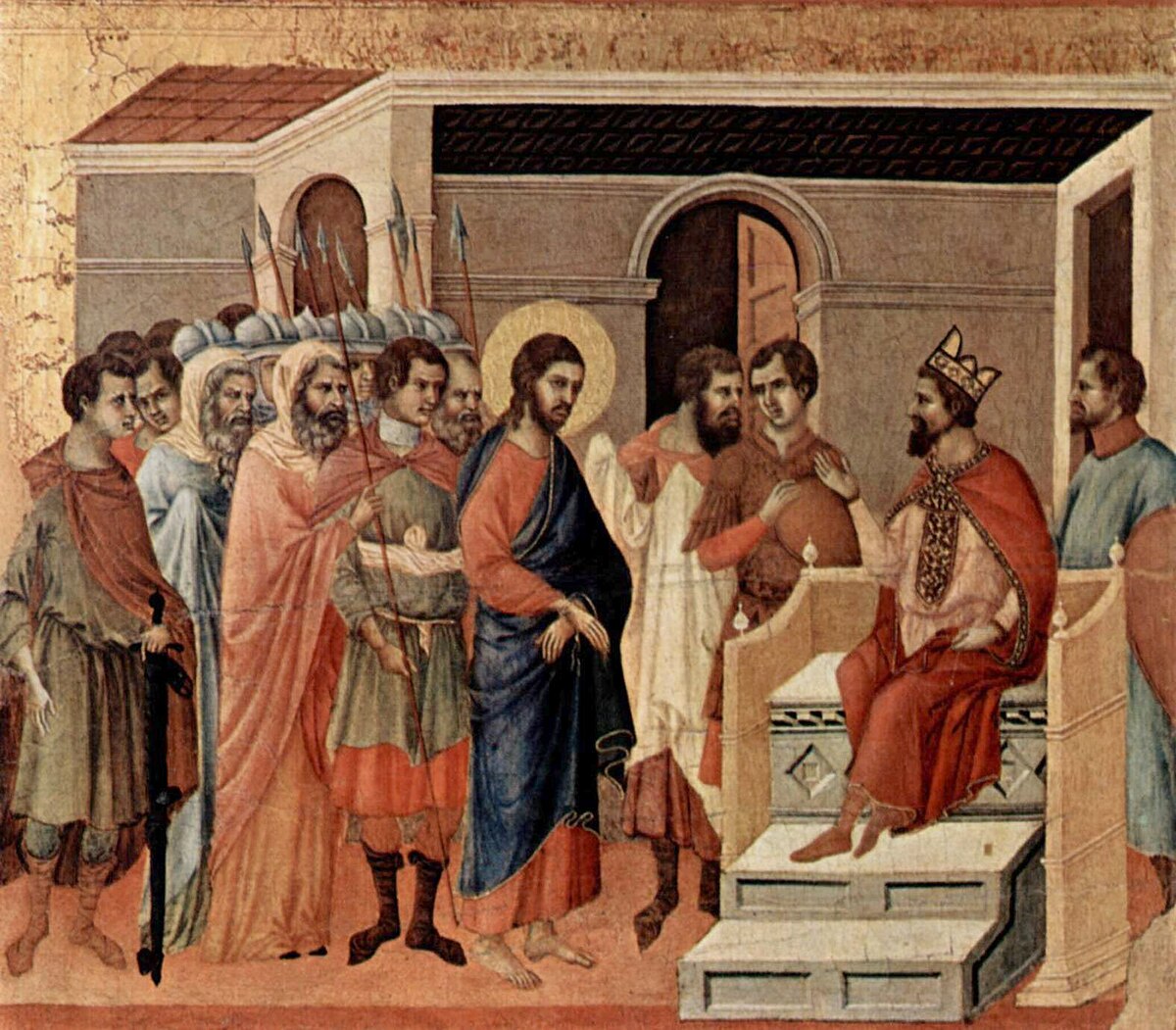Flight into Egypt
For other uses, see Flight into Egypt (disambiguation).
The flight into Egypt is a story recounted in the Gospel of Matthew (matthew 2:13-23) and in New Testament apocrypha. Soon after the visit by the Magi, an angel appeared to Joseph in a dream telling him to flee to Egypt with Mary and the infant Jesus since King Herod would seek the child to kill him. The episode is frequently shown in art, as the final episode of the Nativity of Jesus in art, and was a common component in cycles of the Life of the Virgin as well as the Life of Christ. Within the narrative tradition, iconic representation of the "Rest on the Flight into Egypt" developed after the 14th century.

The flight from Herod
When the Magi came in search of Jesus, they went to Herod the Great in Jerusalem to ask where to find the newborn "King of the Jews". Herod became paranoid that the child would threaten his throne, and sought to kill him (2:1–8). Herod initiated the Massacre of the Innocents in hopes of killing the child (Matthew 2:16–Matthew 2:18). But an angel appeared to Joseph in a dream and warned him to take Jesus and his mother into Egypt (Matthew 2:13).
Egypt was a logical place to find refuge, as it was outside the dominions of King Herod, but both Egypt and Judea were part of the Roman Empire, linked by a coastal road known as "the way of the sea",making travel between them easy and relatively safe.

Return from Egypt
Main article: Return of the family of Jesus to Nazareth
After a time, the holy family returned from Egypt. The text states that Herod had died. Herod is believed to have died in 4 BC, and while Matthew does not mention how, the Jewish historian Josephus vividly relates a gory death.
The land that the holy family return to is identified as Judah, the only place in the entire New Testament where Judah acts as a geographic description of the whole of Judah and Galilee Matthew 2:20, rather than referring to a collection of religious people or the Jewish people in general. It is, however, to Judah that they are described as initially returning, although upon discovering that Archelaus had become the new king, they went instead to Galilee. Historically, Archelaus was such a violent and aggressive king that in the year 6 AD he was deposed by the Romans, in response to complaints from the population. Galilee was ruled by a much calmer king, Herod Antipas, and there is historical evidence that Galilee had become a refuge for those fleeing the iron rule of Archelaus.

Prophecy of Hosea
Further information: Hermeneutics and Pardes (Jewish exegesis)
Matthew 2:15 cites Hosea 11:1 as prophetically fulfilled in the return of Joseph, Mary and Jesus from Egypt:
Matthew's use of Hosea 11:1 has been explained in several ways. A sensus plenior approach states that the text in Hosea contains a meaning intended by God and acknowledged by Matthew, but unknown to Hosea. A typological reading interprets the fulfillment as found in the national history of Israel and the antitypical fulfillment as found in the personal history of Jesus. Matthew's use of typological interpretation may also be seen in his use of Isaiah 7:14 and 9:1, and Jeremiah 31:15.

Another reading of Hosea's prophetic declaration is that it only recounts God summoning of the nation of Israel out of Egypt during the Exodus, referring to Israel as God's son in accordance with Moses' declaration to Pharaoh:
The Massoretic Text reads my son, whereas the Septuagint reads his sons or his children; the Massoretic Text is to be preferred, the singular being both consonant with the other words which are in the singular in Hosea 11:1 and with the reference to Exodus 4:22–23. The Septuagint reading may be explained as having been made to conform to the plurals of Hosea 11:2, they and them.
Christian
The story was much elaborated in the "Infancy Gospels" of the New Testament apocrypha with, for example, palm trees bowing before the infant Jesus, Jesus taming dragons, the beasts of the desert paying him homage, and an encounter with the two thieves who would later be crucified alongside Jesus. In these later tales the family was joined by Salome as Jesus' nurse. These stories of the time in Egypt have been especially important to the Coptic Church, which is based in Egypt, and throughout Egypt there are a number of churches and shrines marking places where the family stayed. The most important of these is the church of Abu Serghis, which claims to be built on the place the family had its home.
One of the most extensive and, in Eastern Christianity, influential accounts of the Flight appears in the perhaps seventh-century Gospel of Pseudo-Matthew, in which Mary, tired by the heat of the sun, rested beneath a palm tree. The infant Jesus then miraculously has the palm tree bend down to provide Mary with its fruit, and release from its roots a spring to provide her with water.
Muslim
The Qur'ān does not include the tradition of the Flight into Egypt, though sūra XXIII, 50 could conceivably allude to it: “And we made the son of Maryam and his mother a sign; and we made them abide in an elevated place, full of quiet and watered with springs”. However, its account of the birth of Jesus is very similar to the account of the Flight in the Gospel of Pseudo-Matthew: Mary gives birth leaning against the trunk of a date-palm, which miraculously provides her with dates and a stream. It is therefore thought that one tradition owes something to the other.
Numerous later Muslim writers on the life of Jesus did transmit stories about the Flight into Egypt. Prominent examples include Abū Isḥāḳ al-Thaʿlabī, whose ʿArāʾis al-madjālis fī ḳiṣaṣ al-anbiyāʾ, an account of the lives of the prophets, reports the Flight, followed by a stay in Egypt of twelve years; and al-Ṭabarī's History of the Prophets and Kings.

No comments:
Post a Comment